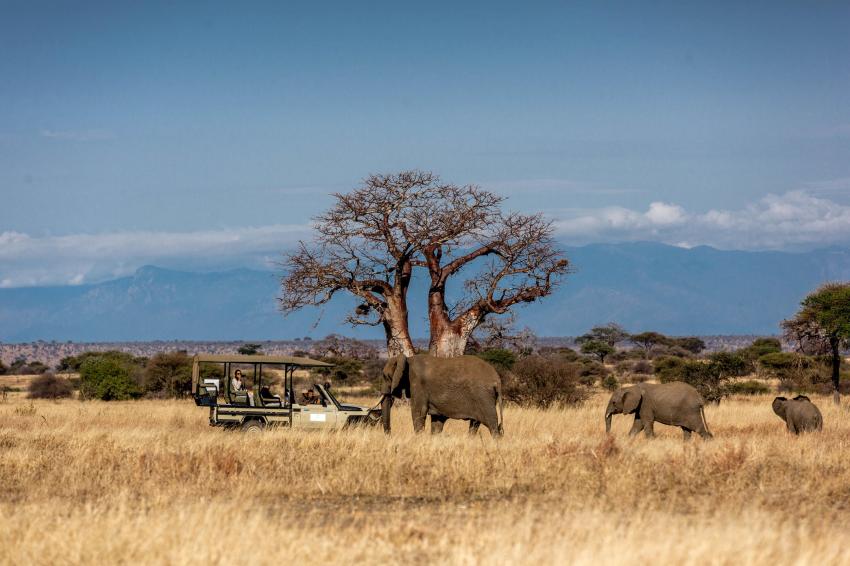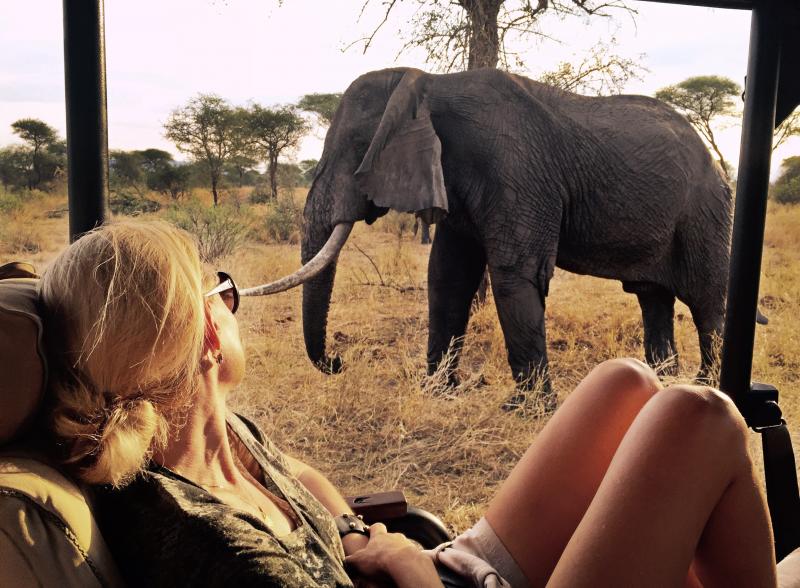Named after the Tarangire River that traverses the reserve, Tarangire National Park sprawls across 2,850 square kilometres in the Manyara Region of Tanzania. Its river provides a major source of water for big game animals during East Africa’s dry season, with thousands of wildebeest, zebras and antelopes congregating here from the surrounding calving areas.

Tarangire National Park encompasses lush river valleys and bird-filled swamps, as well as granite ridges, acacia woodlands and iconic baobab trees. It’s renowned for its migration of large herds of elephants, as well as being an exceptional bird watching destination. While it hosts huge concentrations of animals during the peak periods, it’s visited by only a fraction of Tanzania’s tourists.
Tarangire National Park is slightly off the main safari route through Northern Tanzania, receiving far fewer visitors when compared to the Serengeti National Park and Ngorongoro Crater. Those that do visit often do so just as a day trip or for a matter of hours en route to nearby Manyara National Park.
This makes it an ideal destination to spend a few days for those who want to get off-the-beaten-track and escape the crowds. You can enjoy a much quieter atmosphere while exploring remote landscapes and with a range of authentic safari experiences. Whether you want to do daily game drives, walking safaris or embark on an overnight fly-camping adventure, Tarangire can deliver the safari of your wildest dreams.
What animals can you see in Tarangire National Park?
If you’re visiting Tarangire National Park during the dry period, you’ll encounter a wildlife diversity that’s almost as impressive as the famed Ngorongoro Crater. The wildlife diversity is sourced from a localised migration pattern of species that reside in and around the park, with one of the main highlights being up to 3,000 elephants at any one time. You can also expect to see large numbers of wildebeest, zebra and giraffe, not to mention buffalo, eland and Thompson’s gazelle. Elusive leopards and cheetahs can sometimes be spotted, together with occasional sightings of generuk and oryx.

When it comes to primates, Tarangire National Park is known for its populations of vervet monkeys and olive baboons, while honey badgers and African wild dogs hunt on the grassy plains. It’s also famed for its termite mounds that mushroom throughout the park, providing a home for dwarf mongoose once they’ve been abandoned.
Bird watchers can expect to see any of the more than 550 bird species that have been recorded in Tarangire National Park, making it one of Tanzania’s finest birding destinations. Keep your eyes peeled for African grey flycatchers, ashy starlings and Rufous-tailed weavers, as well as yellow-collared lovebirds and northern pied babblers. Ostriches also reside in the park, together with striking Vulturine guineafowl and Von der Decken’s hornbill.
A number of wildlife research projects are based inside the park, including the Tarangire Elephant Project and the Tarangire Lion Project. The Masai Giraffe Conservation Demography Project also does vital work here, with a white giraffe displaying leucism (partial loss of pigmentation) spotted in 2015.
Game drives are the main safari activity in Tarangire National Park, with some lodges based outside of the park boundaries also offering walking safaris. Game drives normally take place during the cool of the morning and early evening when the animals are at their most active, with open game-viewing vehicles offering a spectacular vantage point. Some vehicles have closed sides with roof hatches so you can stand up and rest your camera or binoculars. Night safaris are also permitted inside Tarangire National Park, although they’re not offered by every lodge and camp.
If you want a real adventure, consider a fly camping walking safari in Tarangire National Park, which will see you spend a night under the stars away from your main lodge or camp in what is an unforgettable wildlife experience. Private fly camping adventures are run by some of Tarangire’s lodges, with an armed guide and small team of staff accompanying you.
How to get to Tarangire National Park
The Kilimanjaro International Airport is the major gateway for visitors heading to Tarangire National Park. Most safaris start from Arusha, which is just under 50 kilometres drive from the Kilimanjaro International Airport. Arusha also has its own airport that offers domestic flights to the Julius Nyerere International Airport in Dar es Salaam and the Zanzibar International Airport.
From Arusha, Tarangire National Park can be reached via a paved road in just under three hours, with the option to stop at Lake Manyara National Park along the way. Many travellers also visit Tarangire on a multi-day safari adventure that includes the Serengeti National Park and the Ngorongoro Crater along what’s known as the Northern Circuit. You can either drive the circuit to and from Arusha or opt to fly one way to the Serengeti’s airstrip if you want to reduce your time on the road.
Best time to visit Tarangire National Park
The dry season from June to October is generally considered the best time to visit Tarangire when there are high concentrations of wildlife inside the national park. The reduction in vegetation and limited water sources make wildlife much easier to spot while the sunny skies are ideal for being out and about. The lack of rain also means a reduction in mosquitoes and tsetse flies, which can be a nuisance between December and March. Keep in mind that lodge and camp rates tend to be at their highest during this period and you should bring plenty of warm clothes as the mornings and nights can get very cold.
November marks the beginning of the wet season, with many animals migrating out of the park to the grazing grounds of the Masai Steppe. If you want to avoid the crowds, it’s still a great place to visit during the rainy season, with short, afternoon showers that won’t interfere too much with travel plans. It’s an ideal time for bird watchers, with migratory birds flocking from Europe and Asia, but visitors shouldn’t expect the high concentrations of game that are found during the dry season.
Where to stay in Tarangire National Park
There are a variety of lodges and camps along the borders of Tarangire where you can stay, as well as those that are situated inside the national park’s boundaries. They range from comfortable camps to luxury lodges, as well as rooms that nestle in ancient baobab trees. If you prefer a hotel-style stay, you can also find accommodation options to suit.
Most of the accommodation is situated in the northern part of Tarangire and within easy access of Lake Manyara if you’re also interested in exploring this majestic national park. Alternatively, you can stay in one of the safari lodges or camps inside Lake Manyara National Park and visit Tarangire from there.
Want to plan an adventurous safari in Tarangire National Park? Check out our comprehensive range of luxury lodges and camps.

 1-321-766-6821
1-321-766-6821 





